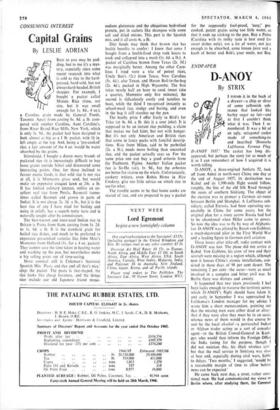ENDPAPER
By STRIX
D-ANOY, a three-engined Junkers 52, took off from Anhsi in north-west China one day at the end of August 1937; its destination was Kabul and its 1,500-mile flight would follow, roughly, the line of the old Silk Road through the oases of southern Sinkiang. The object of the exercise was to pioneer a German air-route between Berlin and Shanghai. A Lufthansa sub- sidiary, called Eurasia, had been operating suc- cessfully in China for some years; but the original plan for a route across Russia had had to be abandoned when Hitler came to power. So now the idea was to fly by way of Afghanis- tan. D-ANOY was piloted by Baron von Gablenz, a much-decorated pilot in the First World War and a leading figure in German civil aviation.
Three hours after take-off, radio contact with D-ANOY was lost. The plane did not arrive at Kabul. Von Gablenz, his crew of two and their aircraft were missing in a region which, although now it houses China's atomic installations, con- sisted in those days of 98 per cent desert. The remaining 2 per cent—the oases—were as usual involved in a complex and bitter civil war. In Berlin there was distress and anxiety.
It happened that two years previously I had been lucky enough to traverse the territory across which D-ANOY's flight should have taken it, and early in September I was approached by Lufthansa's London manager for my advice. I wrote him a short memorandum, pointing out that the missing men were either dead or alive: that if they were alive they must be in an oasis, whence news of them would in due course be sent by the local aksakal—a patriarchal Indian or Afghan trader acting as a sort of consular agent—to the British Consul-General in Kash- gar, who would then inform the Foreign Office via India (using for the purpose, though I did not mention this, his illicit wireless set): but that the mail service in Sinkiang was slow at best and, especially during civil wars, liable to delays. Two months,' I suggested, 'would be a reasonable margin of time to allow before news can be expected.'
He came back next day, a stout, rather emo- tional man. He had communicated my views to Berlin where, after studying them, the German
authorities had authorised him to ask me whether I would undertake the 'rescue' of Baron von Gablenz; they would pay me whatever I liked in the way of remuneration.
I was then on the staff of The Times, and our interviews took place in Printing House Square. Hitler had just expelled Norman Ebbutt, the very able Times correspondent in Berlin, and I did not miss the opportunity of pointing out that the German authorities seemed to have a rather ambivalent attitude towards the paper's employees. I had already stressed, in my memo- randum, the impracticability of attempting any sort of rescue operation, but it seemed rather unsporting to refuse his request: so I said that, if the missing men were reported to be alive and in need of succour, I would see what I could do to help. I added, snootily, that as long as my expenses were paid I didn't want any remuneration. The stout fellow departed, pro- fuse in his thanks; and a very few days after- wards D-ANOY landed safely at Kabul.
The aircraft had force-landed at (I think) Khotan, then in the hands of dissident Chinese Moslems. After various initial misunderstand- ings von Gablenz and his companions were treated well. The engine trouble that had brought them down was not irreparable; after days of hard work they were able to sort it out and resume their flight. When I passed through Ger- many later that year they gave me a dinner and presented me with the casket. I remember von Gablenz as looking rather like a wild boar; I liked him very much. Almost exactly five years after his brief disappearance in Sinkiang, he 'died a flyer's death,' as the German wireless announcement put it: presumably in Russia. I wonder what happened to his crew—Flugkapitan Untucht and Oberfunkermachinist Kirchoff.



































 Previous page
Previous page